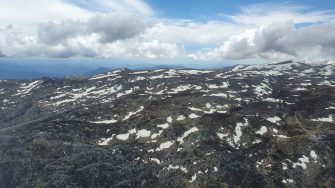
Date: Wednesday, October 21, 2020
Project: Eastern Australian Waterbird Survey
Observers: John Porter UNSW/DPIE, Shannon Dundas NSW DPIE
Pilot: James Barkell NSW National Parks & Wildlife Service DPIE
A break in east coast rain allowed us to set out from Sydney into blue sky, bound for the NSW south coast. Our first stop was the Sydney water supply reservoirs Lakes Avon and Cordeaux – these deep reservoirs have little attractive habitat for waterbirds and we saw just a few birds, mostly little black cormorants. Lake Illawarra was up next and there were low numbers of black swans, pelican, silver gulls, terns and royal spoonbills. We continued southward admiring the beauty of south coast before resuming counting on survey band 2 around Wallaga Lake and Bermagui – these estuaries can sometimes support reasonable numbers but today there were only low numbers of birds – mostly cormorants, black swans, coot and grey teal.
Looking towards Moruya on the NSW south coast
Last patches of snow near Mt Kosciuszko– after melting it will find its way into the snowy river and then the Murray River
After refuelling at Merimbula we turned inland and continue along survey band 2, climbing steeply up the ranges and onto the Monaro tableland and its beautiful freshwater wetlands –most of them were dry and those with water were drying rapidly – there weren’t many waterbirds. Lake Jindabyne was the next stop, and its deep waters are also poor habitat for birds so we weren’t surprised by the usual low numbers. We continued on climbing up over the roof of Australia and its snowfields, the dead trunks of burnt snowgums stretching away as far as the eye could see - a stark reminder of the effects of climate change. Our next counts took in Dartmouth dam with very low numbers of birds and the Mitta Mitta river, where we encountered moderate numbers of straw necked ibis, wood duck and grey teal. Our last task of the day was counts over the Wallenjoe wetlands – a series of freshwater lakes and swamps – around half were dry and several were drying back rapidly. There were low numbers of black, swan, grey teal and Australian shelduck.
Surveying an estuary near Bermagui on NSW south coast
Blog by John Porter
